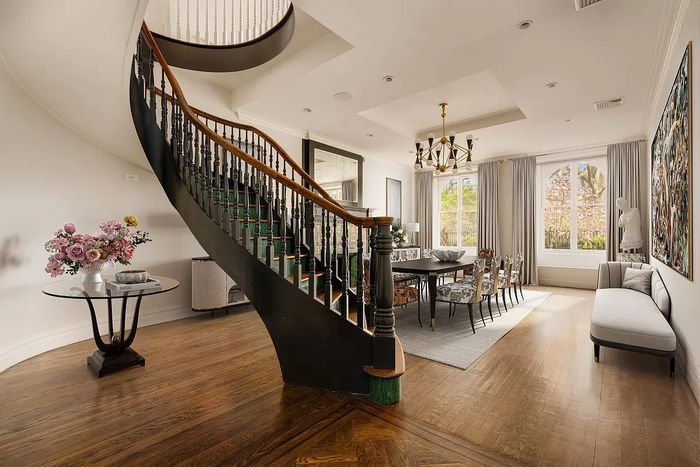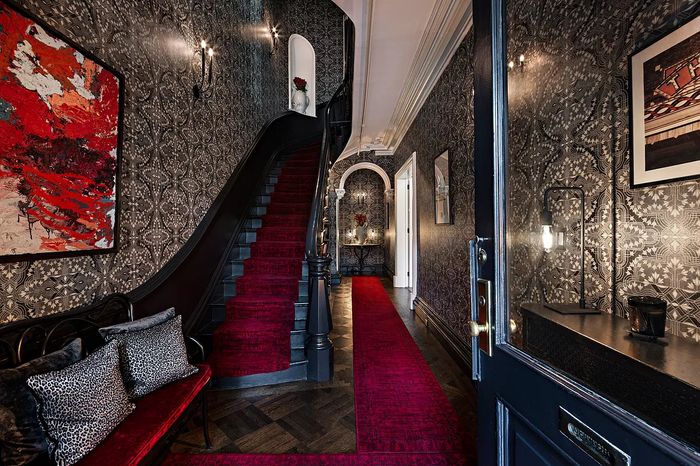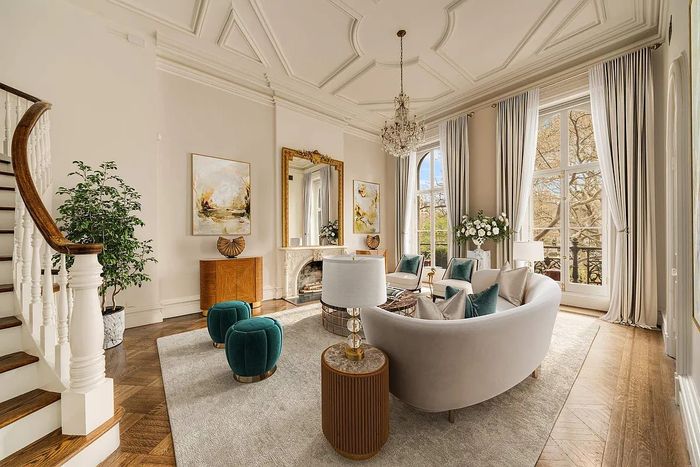The dining room of Baz Luhrmann’s Gramercy Park townhouse, as shown in listing photos, had several hallmarks of his style: red velvet furniture, ornate patterned carpets, heavy baroque wallpaper, and an Art Deco–inspired chandelier.
Photo: Corcoran
Eight years ago, Baz Luhrmann bought a mammoth 28-foot-wide townhouse in Gramercy Park for $13.5 million and renovated it in the distinctive, over-the-top manner familiar to anyone who has ever seen Moulin Rouge! or Elvis: blood-red carpets, black woodwork, and an abundance of dizzyingly baroque wallpaper. When he listed it for sale three years ago, asking for $20 million, the severe, industrial-looking kitchen was staged with a huge bouquet of red roses. But all that glamour and velvet hasn’t seduced a single buyer, and the house has gone through a series of price cuts while progressively losing the Luhrmann look. When it was relisted this month for $13.99 million, it had been almost entirely scrubbed of the director’s signature aesthetic: The kitchen cabinets were repainted a pale gray, the furniture upholstered in creams and whites, and a lot of the wallpaper (although not all of it — the house is 8,500 square feet) had been stripped. It looks lighter, brighter, and considerably more generic. Interior designers and brokers I spoke with were impressed. The consensus is that this time around, it might actually sell.
For decades now, brokers have cautioned sellers against listing a property with design choices that are too specific: bright colors, heavy drapes, dark woodwork, antiques. But now that everyone house-hunts on Zillow and StreetEasy, a highly particular aesthetic is especially damning for sales prospects. “The problem with a property like Baz Luhrmann’s is that you’re going to see it first online,” says Beth Kushnick, a set designer for film and TV who works as a stager. “We’re so used to seeing these neutral spaces where you can really picture yourself there. When you run up against a style like his and his wife’s, it’s virtually impossible to see yourself in that space unless you’ve lived your life in a Baz Luhrmann movie.”
The dining room now, as shown in the latest listing photos, is notably brighter, if also more bland, with less furniture. All that seems to remain of Luhrmann’s style is the chandelier and the patterned steps.
Photo: Sotheby’s International Realty
This isn’t to say that the generally beige-dominated style of shelter mags, design blogs, and staged properties isn’t a particular style of its own. But unlike the consensus on what appears “neutral,” these days “there’s no eclecticness as a common style,” says Kushnick. The affordable cost and relative ease of following design trends mean that everything is West Elm–ified. Consider Dominique Nabokov’s photos of prominent New Yorkers’ living rooms from 1995 and The New Yorker’s 2025 portfolio: Many of the 2025 spaces look as though they’ve been “done,” if not by an interior designer than via what’s filtered down through contemporary expectations of what a living room is supposed to look like now — with a mid-century-modern couch and lamp, a gallery wall, and some pops of color.
The house, as shown in listing photos, was done in an unusually dark and dramatic style. Here, a staircase and landing are heavy on the black and red.
Photo: Corcoran
Meridith Baer, an interior designer whose Los Angeles–based firm does about 2,000 stagings a year, says that she not infrequently runs up against clients with strong design preferences: “Some people think they have great taste but they don’t, and others have a really specific taste that works well for them but is not going to appeal to a lot of people.” Color is a big sticking point: “A lot of times, they just want a lot of color. We do the lecture about wanting to appeal to as many people as possible, and they’ll say, ‘But people like color.’ They can’t wrap their heads around it.”
So as not to argue over every last drape or antique breakfront — “But that was my grandmother’s!” is a frequent objection — Baer prefers to have clients clear out all of their furniture “so we can give it a cohesive fresh look.” They will sometimes do partial stagings, however, if pressed: “We try to tone down their look — bringing in a cream-colored neutral sofa to go with some of their flashy fabrics or a single-toned rug, as opposed to one with lots of design.”
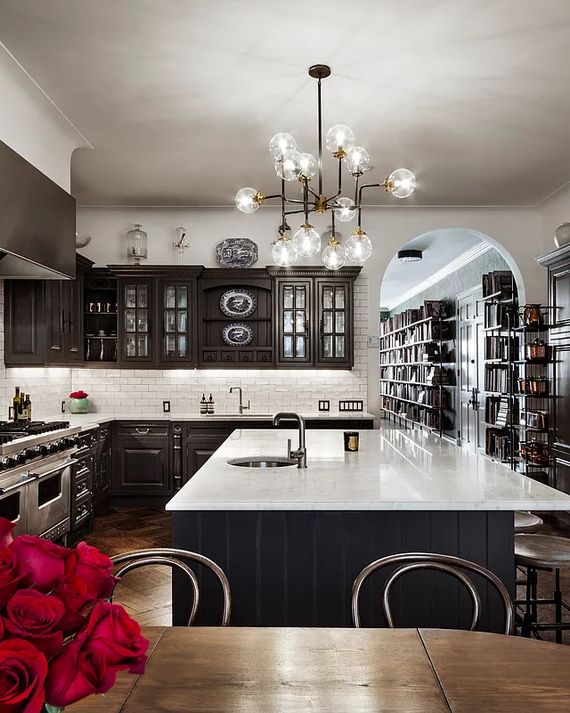
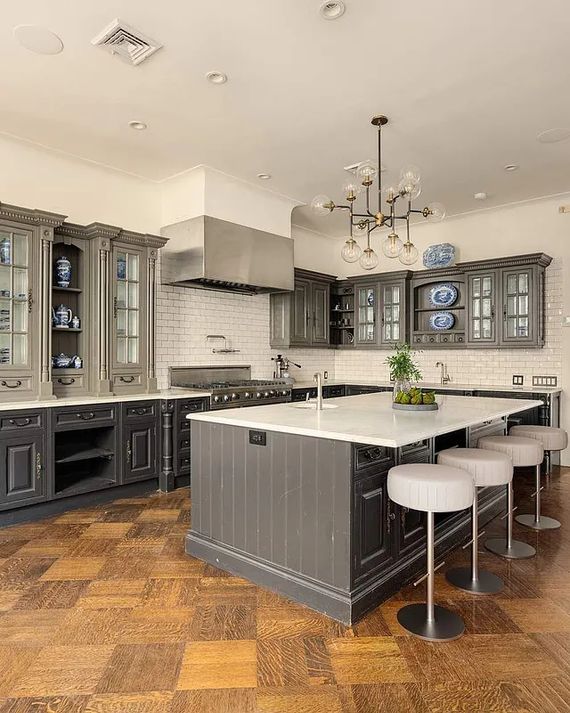
From left: The kitchen, as shown in listing photos, coming off Luhrmann’s renovation, had harsh accents and lots of black. Photo: CorcoranThe cabinetry has since been painted gray and the look otherwise softened, as shown in listing photos of the kitchen. Photo: Sotheby’s International Realty
From left: The kitchen, as shown in listing photos, coming off Luhrmann’s renovation, had harsh accents and lots of black. Photo: CorcoranThe cabinetr…
From left: The kitchen, as shown in listing photos, coming off Luhrmann’s renovation, had harsh accents and lots of black. Photo: CorcoranThe cabinetry has since been painted gray and the look otherwise softened, as shown in listing photos of the kitchen. Photo: Sotheby’s International Realty
And while people who have just done an expensive renovation or redecoration are hard to budge — “If you’ve recently spent a lot of money going in a certain direction, you are really going to have a hard time letting go,” says Baer — the people who are most resistant are the ones who don’t actually want to move at all. It’s the house their children grew up in, or they’re going through a divorce, or they lived there with their spouse who recently died. In those cases, it’s not really a conflict about style; it’s about not wanting to leave.
Erasing someone’s presence from a home can be emotionally fraught, especially when it’s a longtime owner who spent decades lovingly reworking every last surface. Louise Phillips Forbes, an associate broker at Brown Harris Stevens, remembered trying to sell a townhouse like this, at 70 Perry in the West Village, in 2023. The seller had purchased the house in 1977 with her husband, who died a few years earlier. They had completed a renovation in the style popular at the time: a Victorian-era restoration with antique fixtures and furniture, heavy drapes, deep red carpeting, floral wallpaper, and hand-painted borders. “She had beautiful taste, but it was a house they’d owned for 45 years and basically every wall was covered with mementos of their travels and memories and experiences,” says Forbes. Also, “the carpet was a light-sucker.” Forbes found a professional organizer to help the seller with her personal effects, then hired others to clear out a lot of the furniture, paint the walls, and pull up the carpet. The seller asked that they leave the borders — her husband had done a lot of work in the house — and the other changes were enough to brighten up the interiors and draw a buyer.
Even the living room, as shown in listing photos, which was elegant and fairly neutral before, had some changes to soften things up: a pale area rug and emerald green ottomans.
Photo: Sotheby’s International Realty
Some situations are, however, best left untouched. Forbes sold a three-bedroom at 650 West End Avenue to a client a handful of years back and early this year worked with him to put it back on the market. At the time of purchase, he thought the cherry Christopher Peacock cabinets were dated and planned to paint over them but never got around to it. When he decided to sell the place this year, they looked even more off-trend, and he told Forbes he was going to have them professionally painted before they listed. Forbes discouraged him: There are some things digital staging does well, and allowing someone to envision a white kitchen (virtually), rather than paying tens of thousands to painstakingly whitewash one, is one of them.
The worst situations, she says, are sellers who are just stubborn. She is currently consulting on a listing for what should be an $8 million Manhattan townhouse, but she expects it will probably go for closer to $6 million because the seller doesn’t want to tone down the gaudy finishes that sold when he was flipping Brooklyn townhouses 20 years ago — glossy hardwood floors, faux moldings. “People just turn around and walk out when they come to see it,” she says. “When people see a lack of taste like that, they often think there’s a lack of quality behind the walls. It might not be true, but it’s implied.”
As deadly as crimson carpet and heavy brown furniture can be, everyone I spoke with also warned against making things, as Forbes puts it, “too vanilla ice cream.” You want it to be aspirational and neutral with just enough points of interest to anchor someone’s fantasy. People like to imagine they’ll be better versions of themselves in a new place, not different people altogether (and for the most part, not characters in a Baz Luhrmann movie, either). As Baer says, “People think, Gosh, when I move in, I’m not going to have all this clutter. My son is not going to have 70 toys. He’s just going to have two really nice ones.”


